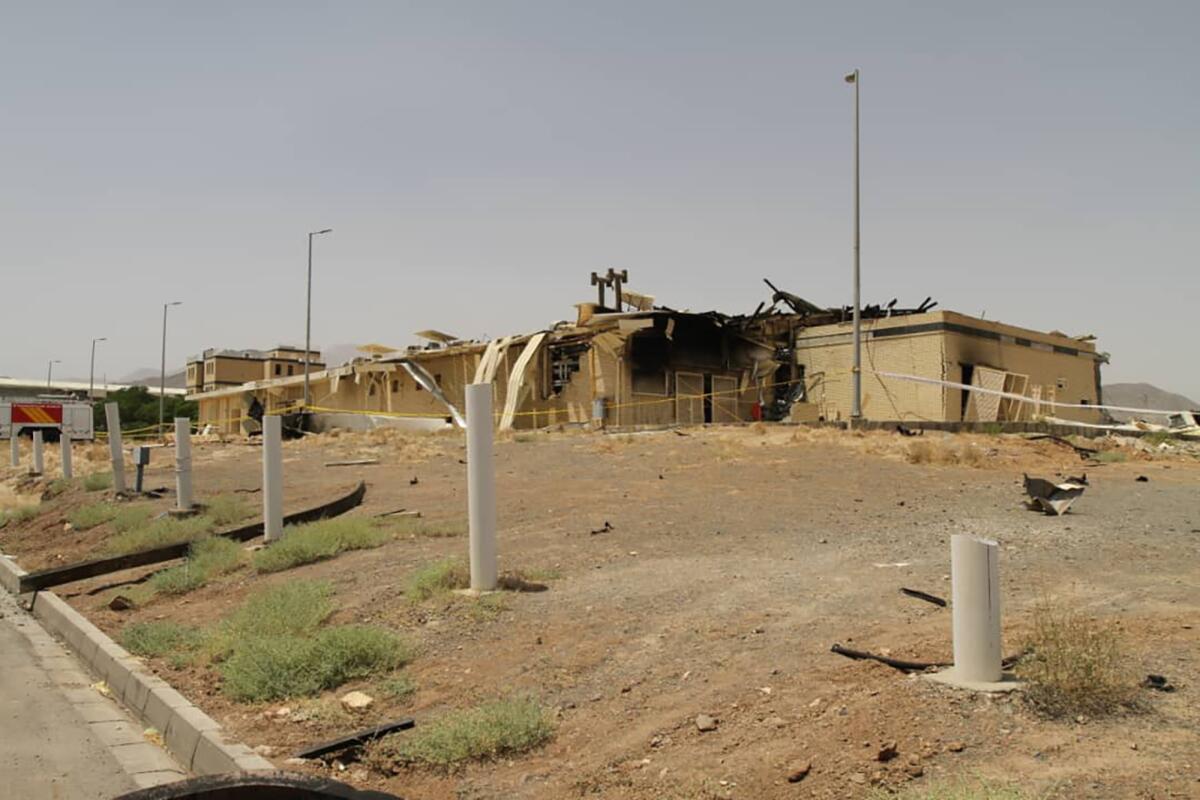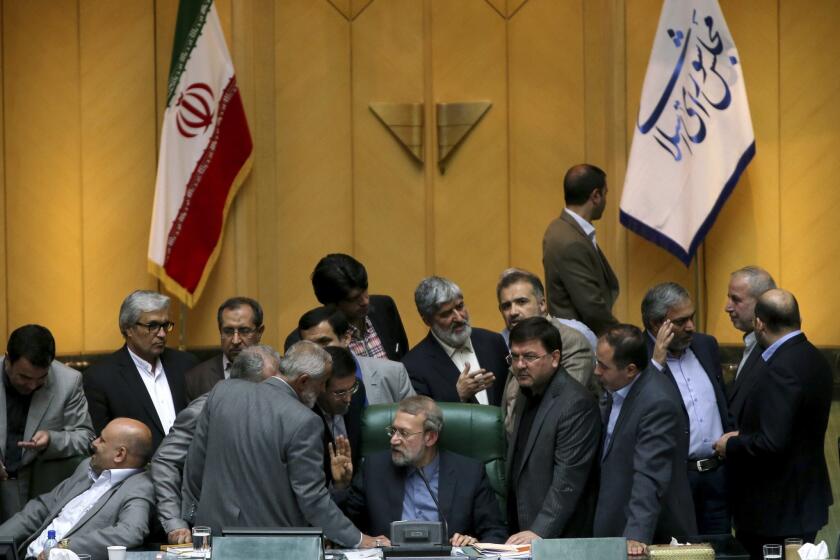Fire at Iranian nuclear site hit new centrifuge facility, analysts say

- Share via
DUBAI, United Arab Emirates — A fire and an explosion struck a building above Iran’s underground Natanz nuclear enrichment facility early Thursday, a site that U.S.-based analysts identified as a new centrifuge production plant.
The Atomic Energy Organization of Iran sought to downplay the blaze, with spokesman Behrouz Kamalvandi saying only that an “incident” had affected an “industrial shed” under construction. However, after the fire erupted, both Kamalvandi and Iranian nuclear chief Ali Akbar Salehi rushed to Natanz, which has been targeted in sabotage campaigns in the past.
Kamalvandi did not identify what damaged the building, though Natanz Gov. Ramazanali Ferdowsi said a fire broke out there, according to a report by the semiofficial Tasnim news agency.
A photograph later released by the Iranian atomic energy agency showed a brick building with scorch marks and its roof apparently destroyed. It was unclear whether that was the “shed” to which Kamalvandi referred. Debris on the ground and a door that appeared to have been blown off its hinges suggested that an explosion accompanied the blaze.
Data collected by a U.S. National Oceanic and Atmospheric Administration satellite suggested that the fire broke out about 2 a.m. in the northwestern corner of the Natanz compound. Flames from the blaze were bright enough to be detected by the satellite from space.
“There is physical and financial damage, and we are investigating to assess,” Kamalvandi told state television. “Furthermore, there has been no interruption in the work of the enrichment site. Thank God, the site is continuing its work as before.”
Iran’s announcement that it will no longer abide by the most important limits in the landmark 2015 nuclear deal could place Tehran back on the pursuit of nuclear weapons.
The site of the fire corresponds with a newly opened centrifuge production facility, said Fabian Hinz, a researcher at the James Martin Center for Nonproliferation Studies at the Middlebury Institute of International Studies in Monterey, Calif.
David Albright of the Institute for Science and International Security in Washington also said that the fire struck the production facility.
Hinz and Albright said they identified the facility based on satellite and TV images.
Iranian nuclear officials did not respond to a request for comment about the analysts’ assessments.
There was no previously announced construction work at Natanz, a uranium enrichment center about 160 miles south of Tehran. Natanz includes underground facilities buried under 25 feet of concrete, which offers protection from airstrikes.
Iran said Tuesday that its top court confirmed a death sentence for an Iranian man convicted of spying for the CIA, with state media alleging that he had shared details of the Islamic Republic’s nuclear program with the American spy agency.
Natanz, also known as the Pilot Fuel Enrichment Plant, is among the sites now monitored by the International Atomic Energy Agency after Iran’s 2015 nuclear deal with world powers.
The IAEA said in a statement that it was aware of reports of the fire. “We currently anticipate no impact on the IAEA’s safeguards verification activities,” the Vienna-based agency said.
Located in central Iran’s Esfahan province, Natanz hosts the country’s main uranium enrichment facility. There, centrifuges rapidly spin uranium hexafluoride gas to enrich uranium. Currently, the IAEA says Iran enriches uranium to about 4.5% purity, above the terms of the nuclear deal, but far below weapons-grade levels of 90%. It also has conducted tests on advanced centrifuges, according to the IAEA.
The U.S. under President Trump unilaterally withdrew from the nuclear deal in May 2018, setting off months of tensions between Tehran and Washington. Iran now is breaking all the production limits set by the deal, but still allows IAEA inspectors and cameras to monitor its nuclear sites.
Breaking News
Get breaking news, investigations, analysis and more signature journalism from the Los Angeles Times in your inbox.
You may occasionally receive promotional content from the Los Angeles Times.
However, Natanz did become a point of controversy last year as Iranian officials refused to allow an IAEA inspector into the facility in October after the inspector reportedly tested positive for suspected traces of explosive nitrates. Nitrates are a common fertilizer, but when mixed with proper amounts of fuel, the material can become an explosive as powerful as TNT. Swab tests, common at airports and other secure facilities, can detect its presence on the skin or objects.
Natanz also remains of particular concern to Tehran as it has been targeted for sabotage before. The Stuxnet computer virus, widely believed to be an American and Israeli creation, disrupted and destroyed centrifuges at Natanz amid the height of Western concerns over Iran’s nuclear program.
Satellite photos show an explosion Friday that rattled Iran’s capital came from an area in its eastern mountains, where analysts believe an underground tunnel system and missile production sites are hidden. Iran blamed the blast on a gas leak in what it describes a “public area.”
Another explosion from a gas leak at a medical clinic in northern Tehran killed 19 people Tuesday.
More to Read
Sign up for Essential California
The most important California stories and recommendations in your inbox every morning.
You may occasionally receive promotional content from the Los Angeles Times.












